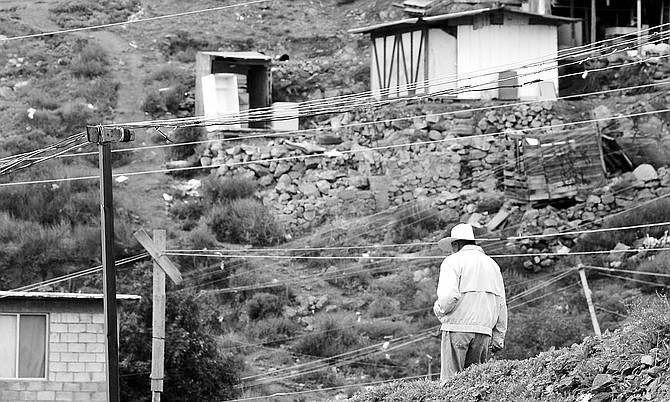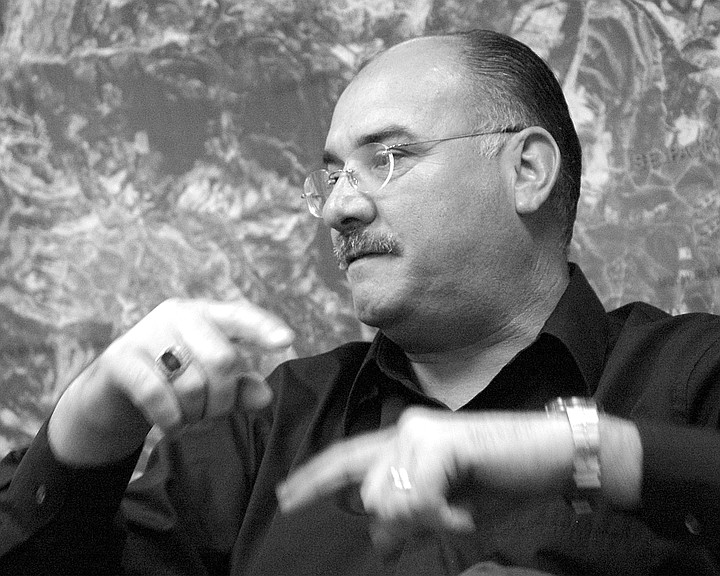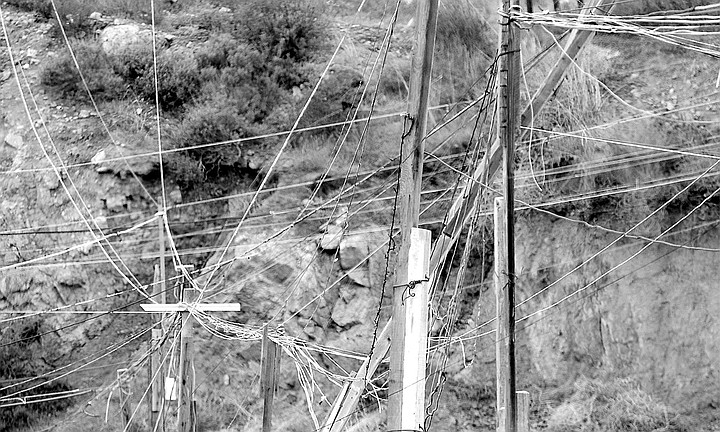 Facebook
Facebook
 X
X
 Instagram
Instagram
 TikTok
TikTok
 Youtube
Youtube

Fifteen or 20 miles east of downtown Tijuana, on the toll road to Tecate, neighborhoods of roughly paved streets and concrete houses give way to dirt roads running amid shacks made of pallets, plywood, and old garage doors. Giant advertising banners cover many of these shacks, transforming them into inadvertent roadside billboards for Budweiser and Tecate beers. It's an odd sight. Even odder -- to American eyes, at least -- is the sight of dozens of red, green, black, and white electrical wires lying in the grass or suspended from makeshift wooden supports tied to fence posts. As children play and goats graze nearby, these wires, illegally strung by the local residents, carry electricity from government power lines -- sometimes hundred of yards away -- to the surrounding hovels. The electrocutions that these wires have caused in the past have earned them the nickname diablitos — little devils — from the locals who live among them.

Officials in the Tijuana zone of the Federal Commission of Electricity find themselves playing the role of Sisyphus when it comes to combating this illegal consumption of electricity in the city's outlying settlements. "Right now," says Javier Larios Castañeda, superintendent of the zone, "we have something like 50,000 illegal connections, despite the fact that we are constantly performing operations to take away these connections. As soon as we finish disconnecting the wires, the people are out there climbing the power poles, connecting new lines, and rolling the wire to wherever their houses are."
Larios, a tall, rugged-looking man with thinning hair and a graying mustache, leans forward from his seat on the leather couch in his 15- x20-foot office. He's sharply dressed in a black shirt over pressed charcoal slacks and black loafers sporting shiny buckles. "One day," he continues with an ironic chuckle, "we confiscated nearly ten tons of wire. In hours, they were back up."

Though it's the usual method, climbing poles and splicing into live power lines isn't the only way electricity is stolen in Tijuana. "The other way," Larios explains, "is done by people with whom we have a contract to provide electricity. But they redirect the wires to take the power before it gets to the meter. It's easier to catch people doing this. We have a permanent program checking the services and the meters of all the users. And if we detect any kind of irregularity, their service is cut. And then we report them for prosecution."
He adds, "They are damaging a means of communication -- that's the term we use -- which is a federal crime."
The Tijuana zone of the Federal Commission of Electricity -- known as the CFE in Mexico -- would love to put an end to illicit consumption of electricity for a few reasons. One is the effect that it has on the quality of service. "Sometimes," Larios, an electrical engineer, explains, "the circuit breakers in nearby houses of our paying customers who have legal connections will pop because of dips and surges in the power caused by illegal connections. So the electrical systems of our paying customers get damaged by all these other people when they hook on or hook off illegally."
Illegal consumption, Larios says, affects more than the quality of power for paying customers. It affects the cost. "We know how much power we get from our wholesalers. And we know how much we bill our customers for. There's a 12 percent differential. The Federal Commission of Electricity has to absorb that loss. That's why we're doing these operations: to try to stop illicit taking of electricity."
But the biggest reason, Larios says, is the risk of electrocution. He points to the windows of his office, which the January rain pelts from the outside. "Particularly in weather like this, a lot of people get electrocuted -- young children, older people, and animals too."
Larios explains, "A lot of these wires are laid in places where cars are driving over them all of the time. When the ground is dry, it's bad enough. But when it's wet, the cover on the wire starts to come loose and they peel. Then you have a lot of kids playing on the ground in puddles. They are barefoot and they make contact with the peeled cables, and that is how they can get electrocuted."
Every year, Larios says, five to ten such accidents are reported, though he suspects there are more that never get reported. He also points out that stepping on the wires isn't the only way to get electrocuted. "Our high-tension wires carry 13,800 volts. Then there are transformers, which lower that to between 120 and 140 volts. That's what the low-tension wires carry. It's after the transformer that these people connect their wires. But some people don't understand that, and they try to connect to the high-tension wires. And they get electrocuted."
Electrocution isn't the only way the diablitos can kill. "They cause fires," Larios says. "The majority of the homes are made out of old wooden garage doors and whatever wood they can find. And they simply put the cables directly through the wall -- no conduit or anything. When there is any kind of wind or breeze, it moves the cables, and the covers slowly wear off, and that provokes the fire."
After a thoughtful pause, Larios adds, "We want people to stop taking these risks."
Though his agency employs a full-time crew to disconnect and confiscate the illegal connections, Larios says they'll never be able to stop it. "It's a social problem," he says. "The three levels of government -- federal, state, and municipal -- simply don't have the capacity to provide the service to cover the demand that all these people have. A recent report that the state and the municipal government did said the city grows, regularly and irregularly, an average of about ten acres a day."
Why does Larios bother sending a crew to disconnect the illegal connections? "Because we have to take video evidence that we're trying to do something about it," he explains. "Because if somebody dies, they could accuse CFE of homicide. So we take video of ourselves removing these illicit connections. It's a way to fight any kind of lawsuit claiming that we are responsible for someone getting electrocuted."
Because he believes the problem is social, Larios believes the solution should be social. "One of the possible options being considered," he says, "is, because the problem is caused by all the migration by people from Sinaloa, Zacatecas, Jalisco, that maybe Baja California could possibly get money from those states to help out and cover the losses. Because these are people that are from those states."
But even in the unlikely event that those states send money along with their migrants, the Federal Commission of Electricity would have trouble spending it on electrifying the outlying neighborhoods; the land they occupy is usually owned by somebody else, and determining just who that somebody is can be a decades-long legal process. "One colonia called Maclovio Rojas," Larios says, "has been established for ten years. But they're still arguing about who owns it. Until an owner is legally established, we can't provide the electrical service. We can't bring power to squatters."


Fifteen or 20 miles east of downtown Tijuana, on the toll road to Tecate, neighborhoods of roughly paved streets and concrete houses give way to dirt roads running amid shacks made of pallets, plywood, and old garage doors. Giant advertising banners cover many of these shacks, transforming them into inadvertent roadside billboards for Budweiser and Tecate beers. It's an odd sight. Even odder -- to American eyes, at least -- is the sight of dozens of red, green, black, and white electrical wires lying in the grass or suspended from makeshift wooden supports tied to fence posts. As children play and goats graze nearby, these wires, illegally strung by the local residents, carry electricity from government power lines -- sometimes hundred of yards away -- to the surrounding hovels. The electrocutions that these wires have caused in the past have earned them the nickname diablitos — little devils — from the locals who live among them.

Officials in the Tijuana zone of the Federal Commission of Electricity find themselves playing the role of Sisyphus when it comes to combating this illegal consumption of electricity in the city's outlying settlements. "Right now," says Javier Larios Castañeda, superintendent of the zone, "we have something like 50,000 illegal connections, despite the fact that we are constantly performing operations to take away these connections. As soon as we finish disconnecting the wires, the people are out there climbing the power poles, connecting new lines, and rolling the wire to wherever their houses are."
Larios, a tall, rugged-looking man with thinning hair and a graying mustache, leans forward from his seat on the leather couch in his 15- x20-foot office. He's sharply dressed in a black shirt over pressed charcoal slacks and black loafers sporting shiny buckles. "One day," he continues with an ironic chuckle, "we confiscated nearly ten tons of wire. In hours, they were back up."

Though it's the usual method, climbing poles and splicing into live power lines isn't the only way electricity is stolen in Tijuana. "The other way," Larios explains, "is done by people with whom we have a contract to provide electricity. But they redirect the wires to take the power before it gets to the meter. It's easier to catch people doing this. We have a permanent program checking the services and the meters of all the users. And if we detect any kind of irregularity, their service is cut. And then we report them for prosecution."
He adds, "They are damaging a means of communication -- that's the term we use -- which is a federal crime."
The Tijuana zone of the Federal Commission of Electricity -- known as the CFE in Mexico -- would love to put an end to illicit consumption of electricity for a few reasons. One is the effect that it has on the quality of service. "Sometimes," Larios, an electrical engineer, explains, "the circuit breakers in nearby houses of our paying customers who have legal connections will pop because of dips and surges in the power caused by illegal connections. So the electrical systems of our paying customers get damaged by all these other people when they hook on or hook off illegally."
Illegal consumption, Larios says, affects more than the quality of power for paying customers. It affects the cost. "We know how much power we get from our wholesalers. And we know how much we bill our customers for. There's a 12 percent differential. The Federal Commission of Electricity has to absorb that loss. That's why we're doing these operations: to try to stop illicit taking of electricity."
But the biggest reason, Larios says, is the risk of electrocution. He points to the windows of his office, which the January rain pelts from the outside. "Particularly in weather like this, a lot of people get electrocuted -- young children, older people, and animals too."
Larios explains, "A lot of these wires are laid in places where cars are driving over them all of the time. When the ground is dry, it's bad enough. But when it's wet, the cover on the wire starts to come loose and they peel. Then you have a lot of kids playing on the ground in puddles. They are barefoot and they make contact with the peeled cables, and that is how they can get electrocuted."
Every year, Larios says, five to ten such accidents are reported, though he suspects there are more that never get reported. He also points out that stepping on the wires isn't the only way to get electrocuted. "Our high-tension wires carry 13,800 volts. Then there are transformers, which lower that to between 120 and 140 volts. That's what the low-tension wires carry. It's after the transformer that these people connect their wires. But some people don't understand that, and they try to connect to the high-tension wires. And they get electrocuted."
Electrocution isn't the only way the diablitos can kill. "They cause fires," Larios says. "The majority of the homes are made out of old wooden garage doors and whatever wood they can find. And they simply put the cables directly through the wall -- no conduit or anything. When there is any kind of wind or breeze, it moves the cables, and the covers slowly wear off, and that provokes the fire."
After a thoughtful pause, Larios adds, "We want people to stop taking these risks."
Though his agency employs a full-time crew to disconnect and confiscate the illegal connections, Larios says they'll never be able to stop it. "It's a social problem," he says. "The three levels of government -- federal, state, and municipal -- simply don't have the capacity to provide the service to cover the demand that all these people have. A recent report that the state and the municipal government did said the city grows, regularly and irregularly, an average of about ten acres a day."
Why does Larios bother sending a crew to disconnect the illegal connections? "Because we have to take video evidence that we're trying to do something about it," he explains. "Because if somebody dies, they could accuse CFE of homicide. So we take video of ourselves removing these illicit connections. It's a way to fight any kind of lawsuit claiming that we are responsible for someone getting electrocuted."
Because he believes the problem is social, Larios believes the solution should be social. "One of the possible options being considered," he says, "is, because the problem is caused by all the migration by people from Sinaloa, Zacatecas, Jalisco, that maybe Baja California could possibly get money from those states to help out and cover the losses. Because these are people that are from those states."
But even in the unlikely event that those states send money along with their migrants, the Federal Commission of Electricity would have trouble spending it on electrifying the outlying neighborhoods; the land they occupy is usually owned by somebody else, and determining just who that somebody is can be a decades-long legal process. "One colonia called Maclovio Rojas," Larios says, "has been established for ten years. But they're still arguing about who owns it. Until an owner is legally established, we can't provide the electrical service. We can't bring power to squatters."
Comments